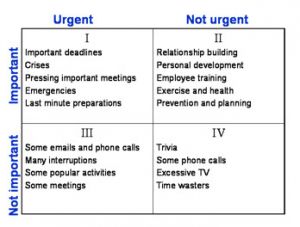Knowing how to prioritise work increases the success of your business
Do the things today that will lead to a lifetime of the things you desire tomorrow
– Brian Tracy
One of your top goals at work should be to prioritise tasks by using your organisational skills to get the highest possible return on your investment of mental, emotional and physical energy.
But it goes beyond that.
Knowing how to prioritise work affects the success of your business, the engagement with and of your team, and your role as a leader.
One of the biggest challenges is accurately prioritising stuff that matters. A natural tendency is to work on the little things but not on the big things.
Even if you have “recommended” or “the best” management software available or if you prefer a written list, you’re the one who enters the information so it must be a process that that’s quick and easy for you to use not anyone else.
Workloads are ballooning and everything feels important. Learning how to prioritise is a positive approach to getting things done. What’s the first step?
Create your Master List.
When you are planning for the year ahead, write a list of all your projects that you know need to be or should be done and everything you can think of on your wishlist to do some time in the future – business and personal
Assess Value – if you are having difficulty deciding which projects or tasks should have top priority, ask yourself which tasks are of the highest value to your business or are sound strategies to meet your goals in the business plan and for a work/life balance.
Identify urgent vs important - Which of these need immediate attention and which will need attention or which would you like to complete within 3, 6 or 9 months.
There are a number of tools that can help you with this such as the examples below.
As well as a daily task list, some people prefer to create monthly and weekly lists from their Master list to manage their time
Monthly list – you make this up at the end of every month for the month ahead
Weekly list – plan your entire week in advance with everything you know has to be completed by late Friday
Daily list
Plan your day the night before – at the end of the work day.
- Priorities are work that if not completed by the end of the day or in the next several hours will have serious negative consequences. Consider if there are any high-priority dependencies that rely on you finishing a task immediately
- Order tasks by estimated effort. There will some tasks you can get out of the way within a few minutes and will enable you to clear your head for tasks that require a lot of thought. On the other hand, getting stuck in to a project early in the day can have its benefits.
- Put the most important, urgent tasks at the top of the list. For the second day, move anything you haven’t accomplished the first day onto the list for the coming day, then add everything you have to do that day. Prioritise your list.
- Be flexible and adaptable. In our industry uncertainty and change are fairly normal. Your priorities can change when you least expect them to but you also want to stay focussed on the tasks you’re committed to completing
- Know when to cut. Mostly we find we can’t get to everything on our list. Focus on the priorities you know you must complete for the day. Assess what you can delegate and assess non-important items that after thought are not going to make much difference to how the business is operating for now, and cut them
- Don’t set unrealistic expectations – set goals and divide them up into small steps … one step at a time. Make a list of everything you have to do to accomplish that goal. The key to time management is for you to choose a sequence of events.



